An A to Z of FT readers’ favourite city runs
This article is from FT Globetrotter
We recently asked FT readers to share their favourite urban running routes. Responses came in from all over the world, extolling the joys of pounding the pavement in cities from Athens to Zurich.
Milan
Montreal
New York City
Nice
Oxford
Paris
Rio de Janeiro
Rome
San Francisco
Shanghai
Singapore
Stockholm
Sydney
Tokyo
Vancouver
Zurich
Athens
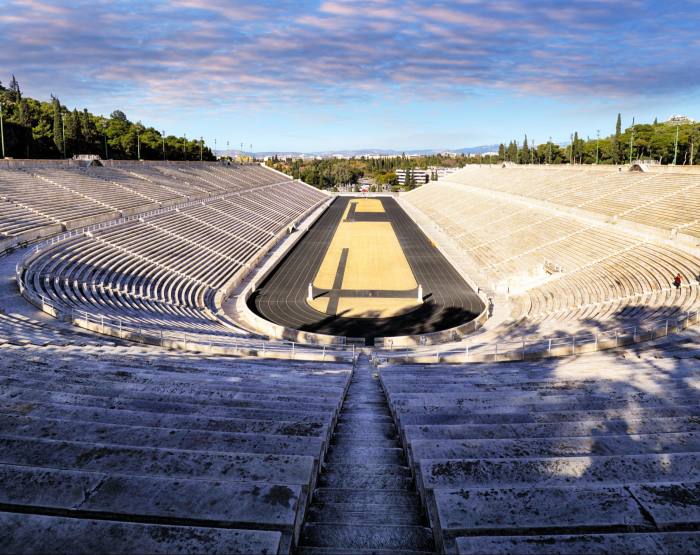
It’s just past 8am in sunny Athina. There is no better place to start a 5k run than the marble Kallimarmaro Stadium, whose stoic beauty has been inspiring runners since 330BC. Running past the Zappeion Hall and the National Garden all the way to the historic district of Plaka allows those who make it there at an early hour to enjoy its quiet charm.
Turning on to Dionysiou Areopagitou and running up the Pnyx Hill is for those who like a little challenge; one is rewarded with the most unique view of the Acropolis and its beauty in the morning sun.
The run continues through Thesseio and Monastiraki where the street musicians and vendors are slowly preparing for the day while sipping freddo espresso. Finally, we make it back to Plaka and continue all the way back to the Kallimarmaro Stadium, where so many runners before us have finished their marathon efforts.
This extraordinary run allows one to get lost in the history and beauty of the ancient capital of Greece.
— Dawid Sawicki, head of finance, Athens, Greece
Back to top
Auckland
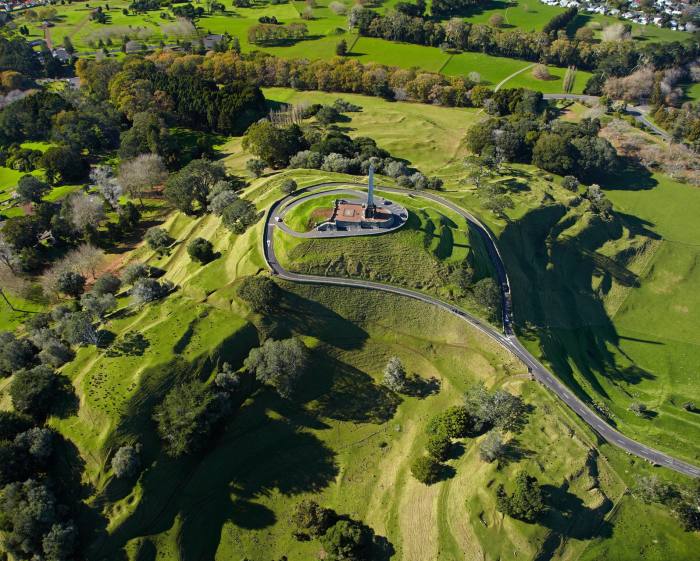
My 6km run is most beautiful at dawn or dusk and starts at Cornwall Park’s Manukau Road entrance.
Cornwall Park and Maungakiekie (One Tree Hill) are two independent parks that form a 670-acre Garden of Eden in Epsom, a central suburb of Auckland.
I run on a trail by the olive grove, passing the observatory and planetarium. I complete a clockwise loop of the park towards Twin Oak and Kenneth Myers Drive. Running through the park I often hear the song and cooing of New Zealand’s distinctive birds like the tūī (an energetic bird with a white tuft on its throat that looks like a bell) and the kererū (a large, colourful pigeon).
The park is a striking expression of New Zealand’s lush forestry, biodiversity and agricultural background. Native trees shelter native bird and insect species. Its farm is worked 365 days per year and is home to sheep and cattle.
After completing the 5km loop of the park, I ascend Maungakiekie for a short but steep high-intensity burst. Maungakiekie is a volcanic peak in the middle of Cornwall Park that rises 600ft above the surrounding area. The volcano erupted around 67,000 years ago and it is the second largest in Auckland’s 53-volcano volcanic field. Maungakiekie was one of the largest pre-Iron Age forts in the world, at one point home to thousands of people, and holds special cultural and archaeological significance.
From the steep trails to Maungakiekie’s summit that I ascend on my run, the outlines of terraces and pits that once contained housing, fortifications, storage and kūmara (sweet potato) gardens are visible. The summit provides awe-inspiring views of Auckland’s city, ocean and Rangitoto Island (Auckland’s largest volcano).
After descending Maungakiekie, a chic café called Cornwall Park Bistro, which operates out of a 115-year-old villa, is a great spot to enjoy a cold one after a run.
— James Hollier, investor, New York, US
Back to top
Austin
My watch reads 7.15am, it’s 90 degrees out and my heart rate is pushing 170.
Right now I’ve just passed Congress Avenue, south of Lady Bird Lake (aka Town Lake), heading east. The Ann and Roy Butler Hike and Bike Trail that skirts the lake is my go-to run. The trail includes detours through and around parks, a 1.3-mile boardwalk and access points to other trails that cut north into the city or run south. Several bridges crossing the lake that provide various vantage points of the Austin skyline also allow runners to adjust their mileage, with the full loop stretching a little over 10 miles.
My advice is to cross the pedestrian bridge or the first street bridge going into the city so that you run straight into the skyline. The uneven gravel surface that covers most of the trail, along with the occasional hill, makes for a run that’s surprisingly challenging. Add in some dry, summer heat to suck the water out of you, and this run will beat you up. It’s tough enough to stay entertaining, but easy enough for training. In summer, run in the mornings or face the Texas heat. In winter, at 3pm the sun will be out, with the cool, dry air an absolute perfect 45-55F.
The best part of the loop is the reward at the end, unique and special to Austin: a dip in Barton Springs.
— Chris Dmuchowski, Package Reliability Engineer, Austin, US
Back to top
Barcelona
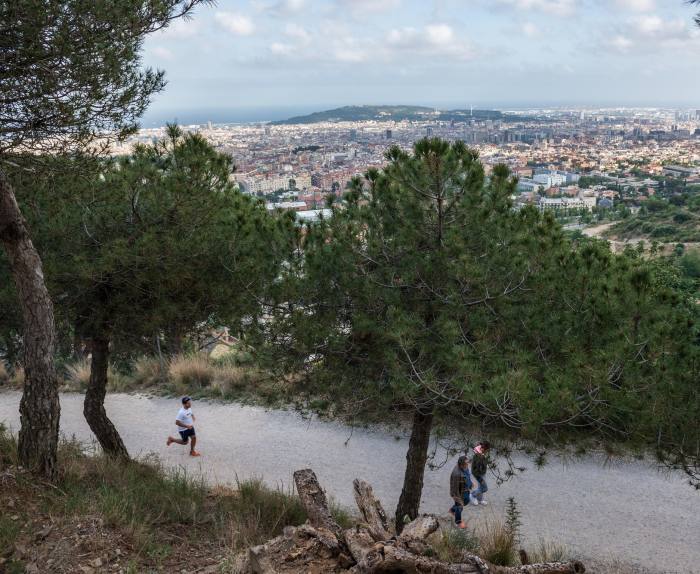
The best place to run is Barcelona is around Collserola, where Tibidabo mountain is. There is a path called Carretera de les Aigües (Path of the Waters). Go there in the mornings, right before the sun rises over the sea. It’s magical. You are by yourself, with the city at your feet, clean air and a beautiful panorama.
The path is 9km long, so going back and forth makes it a good 18km run. There are water fountains along the path. And furthermore, you have a whole mountain for you. You can explore thousands of paths. The other side of the mountain is also incredible: you lose track of Barcelona, and it feels like you’re a long way from civilisation, when in fact you are just a few miles away.
I’ve had the opportunity to run in most major cities, and none gives the same experience as the one I have here, waking up first thing in the morning, and getting myself lost in Collserola.
— Jorge Lluch, entrepreneur, Barcelona, Spain
Back to top
Boston
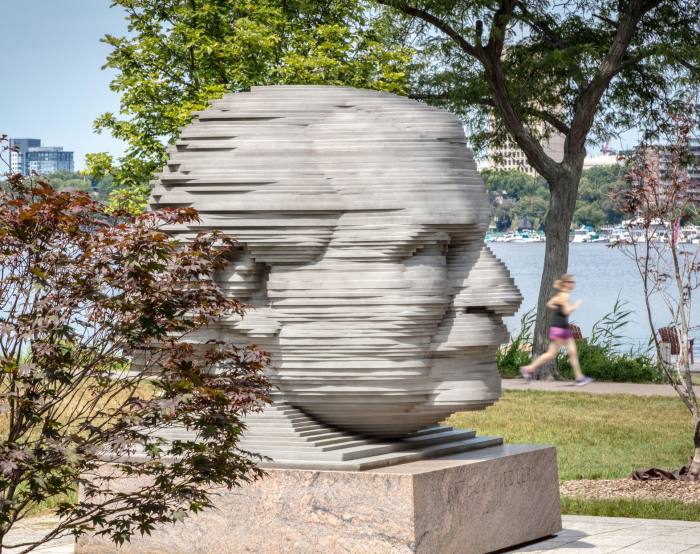
My favourite business-travel run is in Boston. I start by heading up Charles Street towards the Public Garden, then I take a right on Beacon Street and head downhill. As soon as you hit that last corner of the Public Garden, go right and join the Arthur Fiedler Footbridge that takes you over the traffic and slides you on to the Charles river footpath. I like to run the path closest to the river — it is dirt and well-worn and puts you right on the river with the early- morning fishing crowd. Boston wakes up early, especially on a warm morning in spring or fall.
Other runners join from all over Back Bay — you will find almost any pace to run alongside. And the river wakes up early as well, dotted with sailors, rowers and coach boats, so you have lots of company. Your first mile will click by before the Harvard Bridge; run under it and head to the Boston University Bridge. Pay attention to the path — it heads over the expressway at around the 2.3-mile mark. You push through a bit of the BU campus and run parallel to Commonwealth Avenue. Don’t miss the Citgo sign over Fenway.
Cross the river then turn right. Along Memorial Drive run by the boat houses, and pass Massachusetts Avenue and the Harvard Bridge again. The Great Dome at MIT is on your left at around the four-mile mark. There is a cloverleaf approach to the Longfellow Bridge, where your mile five will pass. Follow the exit off the bridge and pick back up on Charles Street; take a left on Pinckney Street. It is a climb where you pass cobblestoned Louisburg Square — such a gem of a park and a collection of beautifully restored homes. At the end, take a right on Joy Street (downhill). Cross Beacon Street into Boston Common and see the gold dome of the state house, and angle left through the Common, loop the T-stop at the corner of Tremont and Park (look at the Park Street Church as you turn around the station building. It is where “My Country ’Tis of Thee” was first performed).
Run the middle walkway back towards the Public Garden. End your run at the “Make Way For Ducklings” sculpture — and that’s 10k!
— Randy Webb, family office finance, Virginia Beach, US
Back to top
Brussels
An advantage of running in Brussels is that the city has a large park which then merges into a forest, providing great choice of length, elevation and surface. If you’re staying in or around the iconic Avenue Louise, just start jogging south along its side alleys, while looking at some very beautiful Art Nouveau and Art Deco buildings, until you veer into the magnificent Bois de la Cambre. You can run around its lake or the main road, which is car-free on Sundays, before returning to the city on a pleasant, slightly downhill jog on the opposite side of the avenue. If you still have the energy, I recommend you cross from the Bois to the Fôret de Soignes, where dozens of paths offer a very refreshing run in the woods. You may encounter horse riders, skaters or dogs and their walkers. Anything from 5km to 20km is easily done without passing by the same place twice.
— Paolo Marini, insurer, Küsnacht, Switzerland
Back to top
Cape Town
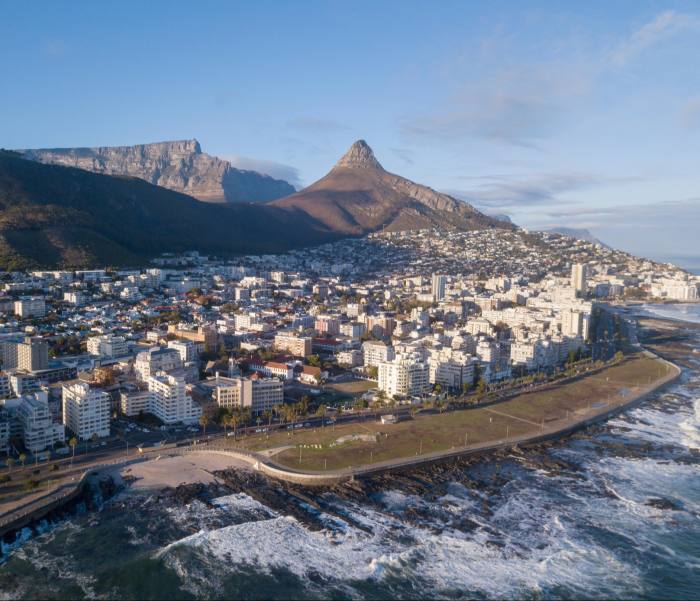
There are surely few better 5k runs than that offered along Cape Town’s Sea Point Promenade. Starting from the lighthouse near the northern waterfront, one runs towards the glitzy beaches of Camps Bay, with the Lion’s Head on the left and the Atlantic on the right. The sea breeze emanating from the direction of Robben Island keeps one cool and the nostrils fresh with salty air. As long as the many cyclists and their dogs can be evaded, the easy gradient paired with the motivation spurred by the many other fitter athletes make it an ideal route to post a new PR. For the brave, 5k can be raised to 10k or more by simply continuing along the coastal road. An icy dip in the water is a gratifying and replenishing reward, a tonic rivalled only by a frosty beer in any of the bars and restaurants passed on the way.
— Jack Calland, consultant, Cape Town, South Africa
Back to top
Chicago
Chicago’s Lakefront Trail made me a runner. This 18-mile paved path follows the Lake Michigan shoreline on the city’s eastern edge, taking runners through lush parks, past sandy beaches, boat docks and one of the country’s most renowned skylines. Morning runs are breathtaking as the sun rises over the water, casting a golden flow while the city comes to life.
My favourite run starts downtown at the Ohio Street Beach, located in the heart of Chicago’s downtown Streeterville neighbourhood and next to its iconic Navy Pier. Headed north, you’ll run right next to the water and may even get splashed if the waves are high. You’ll wind your way along sandy beaches, with beachfront restaurants on Oak Street and North Avenue beaches, before coming to lakefront Lincoln Park at Fullerton. Here, The Lakefront Restaurant at the historic Theater on the Lake provides scenic views of the water and the downtown skyline.
If you are running on a Wednesday or Saturday, turn left on West Fullerton Avenue and run across the Lincoln Park Lagoon, where the Chicago skyline rises above crew teams rowing along the gentle water. Turn left on North Stockton Drive and head south through the formal gardens of Lincoln Park Zoo before reaching Green City Market, a farmers’ market featuring dozens of local, sustainable growers and food producers.
Hop across the street [from the market] to take in the restored South Pond, which features native prairie grasses, and the Nature Boardwalk leading to a bridge that looks out over that gorgeous skyline. Need a bite to eat? The Patio at Café Brauer, part of Lincoln Park Zoo, overlooks the pond and serves coffee, cocktails, small bites and hamburgers.
When you’re ready to head back downtown, follow the path along Stockton underneath West LaSalle Drive and back east to the lakefront trail. There’s no better runner’s high than running right towards Chicago’s skyscrapers with the wind from the lake blowing through your hair.
— Tracy Samantha Goodheart, PR strategist, Santa Anna, Texas, US
Back to top
Edinburgh
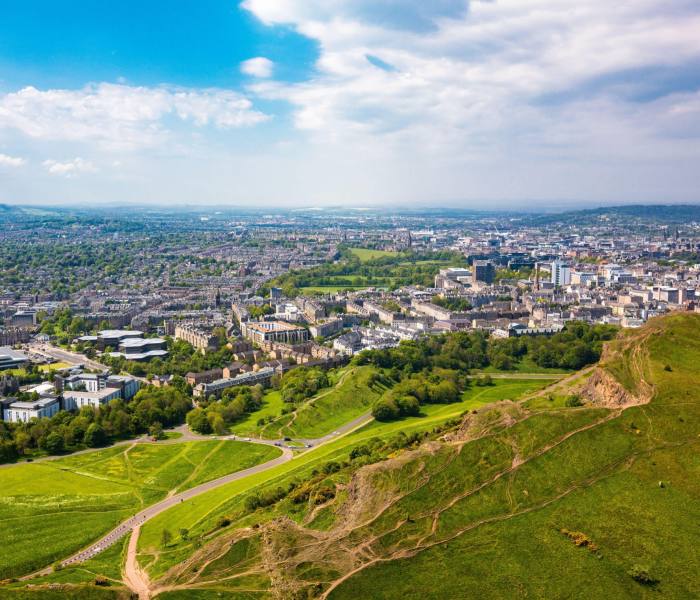
Edinburgh offers the best run in the world. We have the opportunity to run around Arthur’s Seat, which has both beautiful views and a variety of routes to take — either on the road or many different trail runs up or around both Arthur’s Seat and the Salisbury Crags. From the centre of town, it is roughly a five- to 10-minute-run to the start of the park and then it is about 5km around should you follow the road. It is great to be able to get some hill running so close to the city. The views are full 360 degrees looking over Edinburgh, the Pentland Hills and then towards East Lothian.
— Adam Rae, banking, Edinburgh, UK
Back to top
Havana
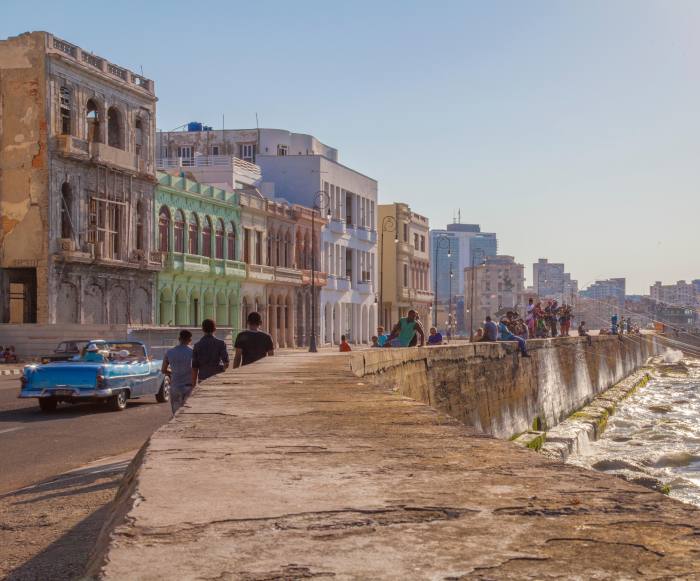
One of the most beautiful and scenic routes I have ever run was recently in Havana, Cuba. I would consider myself well travelled, but Havana is really unusual in its energy, scenery and the pure unfiltered passion you experience with the people. A morning run from Parque Central is a great place to start as you can run past both the Museo Nacional de Bellas Artes (Museum of Fine Arts) and the Museo de la Revolución (Museum of the Revolution). Eventually, you reach the San Salvador de la Punta fort and can run right along the coastline. The feeling of running in the Cuban heat while being gently cooled down by an ocean spray next to you is a pretty unique experience. Any good run isn’t complete without a coffee, and Café Arcángel is top notch. Sitting here, enjoying a coffee and imagining one is as interesting as Hemingway is never a bad way to end a run.
— Chris Grant, account manager, London, UK
Back to top
Hong Kong
A challenging but utterly rewarding run in Hong Kong: [start around the apartment blocks] on Old Peak Road and head straight up the pedestrianised road all the way to the Peak Galleria. Ignore the crowds and the smelly trash cans and turn right on to Lugard Road for a gently sloping run along the edge of Mount Austin. Take in what I think is one of the greatest views in the world until you get to Lugard Road Lookout for a bit of stretching.
Now that the hard work is done it becomes a series of undulating ups and downs. Continue on Lugard Road, which then becomes Harlech Road, and head back to the Peak Lookout café to be rewarded with more breathtaking views over to Lamma Island, the South China Sea and beyond.
At the Peak Galleria, keep running until you intersect with Barker Road under the Barker Road tram stop. Then run along Barker Road with fine views to your left of the Mid-Levels and Victoria Harbour.
Where Barker and Peak Roads intersect, turn left on to Peak Road and run 100m until you reach the junction with Magazine Gap and behold the view north to Kowloon and south to Mount Cameron. Turn south on to Coombe Road and drop down the hill. Take a last look at the vistas before you dive into the jungle . . .
Here endeth the hard part of the run. It’s now downhill all the way as you follow Coombe Road to the east, through Wan Chai Gap Park and on to Black’s Link, where you can soak in the greenery around and above you, joining up with HK Trail Section Four until you amble into Wong Nai Chung. If you are minded to go on, continue to Tai Tam Country Park and on to Shek O but I’ve never bothered. Here I get a cab back and prepare for a hearty lunch at the Summer Palace in Island Shangri-La to replenish the calories I’ve burnt.
— Adrian Simon Tiwari, investor, Dubai, UAE
Back to top
Istanbul

For the adventurous: a 12-15km return run along the Bosphorus in Istanbul, starting in the artsy dockside neighbourhood Kädiköy and following the strait past the gates of the Dolmabahçe Palace, under the cross-strait bridge, through the leafy waterside neighbourhoods of Bebek and Emirgan, under the second bridge and turning around at the picturesque harbour at İstinye. Along the route: Ottoman palaces, a 16th-century mosque, many tankers and foreign-flagged cargo vessels and plenty of İstanbullular enjoying the vistas. However, this is not a run for the faint-hearted: while you trace the Bosphorus littoral road (it is visible 90 per cent of the time), you do so on narrow and changing sidewalks, through the occasional crowd of cross-strait commuters and directly amid the traffic on the road itself before you reach the seawall. It helps that you will see the occasional runner doing the same.
— Jacob Parry, legal publishing, Brussels, Belgium
Back to top
Kyoto

For a longer distance — and if you enjoy the hills — then I would recommend the Kyoto Isshu trail. This follows the horseshoe of hills around the east, north and west of Kyoto. It goes past numerous temples and shrines, the more famous of which include Fushimi Inari, with its multiple torii gates and the Ginkaku-ji (Silver Pavilion) and dropping into Arashiyama. Stunning views of Kyoto are provided, and it is a delight to run during the spring. Just don’t try during summer.
— Robert Sturges, consulting, Dorking, UK
Back to top
London
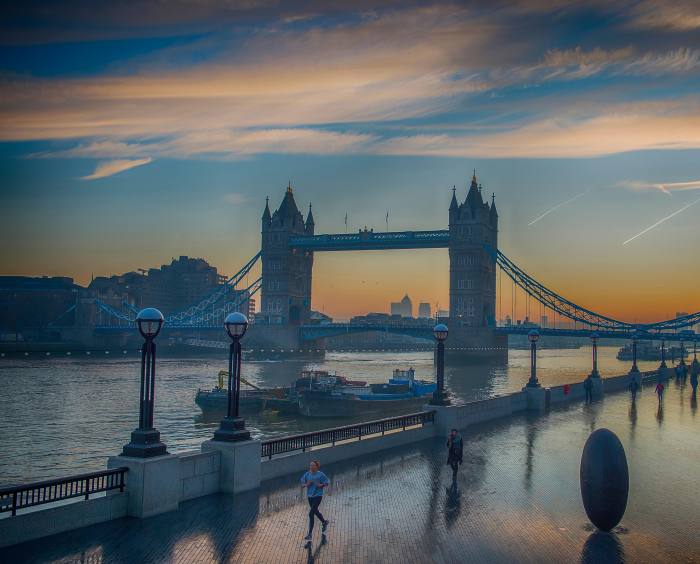
Along the Thames: I have enjoyed running from the Tower of London to Battersea Park, heading out on the north side of the Thames and returning on the south. The route is about 13 miles total, and passes many of iconic London landmarks, such as the Tower of London, Tower Bridge, St Paul’s Cathedral, Tate Modern, the London Eye and the Houses of Parliament. It’s a great way to see the city via an easy flat run. It is also well signposted along the Thames Path.
— Georgia Begley, finance, London, UK
Hampstead Heath: The best run in London is the full circuit of Hampstead Heath, starting at Parliament Hill playing fields, going all the way up to the West Heath, the Pergola and Hill Garden (a hidden gem), into the Heath Extension and back through Kenwood House to finish on Parliament Hill or, even better, the Highgate Ponds for a post-run dip. It’s all within Zones 2 to 3 of the Underground (around six to eight miles in a loop depending on the precise route). The best time to do it is early, before the crowds descend on Kenwood House and before the ponds become too busy (particularly in summer) and with enough time to pick up an ice cream or coffee at Kenwood House before your dip. The pre-ponds run is the perfect way to warm your body to prepare it for the bracing waters, which are a great post-run recovery aid.
I love this route because it can be done year round and there’s wonderful variety along the way: native and non-native trees, stately homes, hills and viewing points and ponds. Nowhere else in London responds to the seasons like Hampstead Heath.
— Richard Bulmore, lawyer, London, UK
Alexandra Palace: The Alexandra Palace perimeter run (6k): starting clockwise through an avenue of lime trees, the perimeter route proper initially drops away down to a wooded section alongside the Hornsey Water Treatment Works. This buffers the slug of railway tracks leading north out of King’s Cross. The path then opens out and skirts round the southern fields which, until 1970, formed part of a racecourse (it is now a cricket pitch). A heavy uphill eventually winds you out at the south terrace of Alexandra Palace itself, for my money the single best view of London (bar crossing the Thames on a night flight into Heathrow). It is a sweeping vista from Canary Wharf to the BT Tower via the Shard, and you can even make out the radio masts at Crystal Palace on a clear day. The best time to go is first thing when the kids are still asleep. In the winter, the sunrise over the City more than makes up for the cold start. Lung-busting extensions to Highgate Wood and Finsbury Park along the disused railway line (Parkland Walk) for those rare days when 6k and 115m of elevation gain aren’t enough . . .
— Charlie A, dad, London, UK
St James’s Park: My standard run when in London is a 6k around St James’s Park. It is perhaps one of the most beautiful city-run experiences, especially at sunrise.
A run around the park (2k loops) is a treat for the senses. Greenery, geese, lakes and nature are really what make a run special, especially one in the heart of a city and St James’s Park has all of these and much more. You can see the changing of the guard and maybe a palace royalty motorcade, all seamlessly blending with the morning yogis, runners, cyclists and “meditationers”. A café right across the lake is the ideal end to the run. A cup of coffee on a bench watching geese talk and water flow marks the end of a beautiful run and the beginning of an even more beautiful day.
— Rajeev, entrepreneur, Chennai, India
North London: My favourite route starts off near my local pub, the Myddleton Arms (a small pub with a great vibe located on Canonbury Road), running a 5km loop which first winds along the New River Walk to Petherton Road. The New River Walk is a small strip of green space and is great in any season — although I prefer it in late summer and autumn.
The run then meanders down the middle of Petherton Road with a chance to admire the trees lining the path and a reminder to book oneself a table at the classic local haunt Primeur. After Petherton Road I cross into Clissold Park — my favourite park in London (aside from Richmond Park). The path I follow goes past the deer enclosure, which allows for a pit stop if I’m not in the mood to put up a good time on Strava. I then admire the view of the church spire and think of making weekend plans to take a stroll along Church Street or a walk around Abney Park Cemetery.
Finally, on the way back, I huff and puff up the small hill back towards Petherton Road and I’m on the home stretch — for some reason this small hill has a psychological hold on me and I struggle to regain my breath, but typically manage to do so towards the Snooty Fox opposite Canonbury Overground station.
This run is special to me simply because it is my go-to route no matter the weather or the season, and its accompanying sights, smells and sounds will be forever etched in my memory.
— Nick Lindsay, lawyer, London, UK
Back to top
Melbourne
The Yarra River: My favourite route to run in Melbourne is alongside the Yarra river, starting in the middle of the city (CBD) on the iconic Princes Bridge. From here you can run east, having the Royal Botanic Gardens on your right and the river on your left for approximately 2km. Then if you keep going in the same direction, you’ll still have the river on the left and the Gardens will be replaced by some beautiful buildings, houses and parks in the South Yarra suburb. This route is very safe as it is shared only by runners, pedestrians and a few bikes (but mainly runners). My favourite time of the day for it is early in the morning as, when it’s not raining, you might see a few hot air balloons.
— Diana Santibanez, investment analyst, Melbourne, Australia
The Tan Track is an almost 4km run that goes around the Royal Botanic Gardens in central Melbourne. It is mainly compacted gravel but also has a bitumen path which leads up to a steep incline known as Heartbreak Hill. It’s good for running any time of the day; there is something special about it whether it’s an early-morning, lunchtime or early-evening run before the sun sets. The route is good for timed trials (there are two digital clocks), and the distance and inclinations in the track from the fast flat bits to the steep hill are perfect for tailoring runs to your running/fitness goals. In terms of sightseeing, you can catch the city skyline and the Shrine of Remembrance while traversing the gardens. There is metered car parking near the entry gates.
— Konstantinos Mossios, chartered accountant, London, UK
St Kilda Beach to Albert Park Lake: I live in Melbourne and my favourite running route is 10km along St Kilda Beach and around the Albert Park Lake (which becomes our Formula 1 track for one weekend in March).
This run features Melbourne’s incredible wealth of nature, cosmopolitanism and seaside vibes. St Kilda comes alive in summer, making it the ideal run to do early on a weekend morning. I love running this route with my young son on his bike and soaking up the sunshine and joie de vivre of St Kilda.
Highlights are Luna Park, the seaside theme park in St Kilda featuring the big face at the front named Mr Moon. Albert Park features the Bunurong Corroboree Tree, a 500-year-old giant red gum, a meeting place and sacred site for the local Bunurong people. St Kilda Pier features the beach, beachside bars and a colony of beautiful little penguins. There’s also The Espy, one of Melbourne’s grand old hotels and which once hosted Mark Twain. And the St Kilda Botanical Gardens contains a giant chessboard and an ornamental pond with the Rain Man fountain.
— Noel Hanssens, data manager, Melbourne, Australia
Back to top
Mexico City
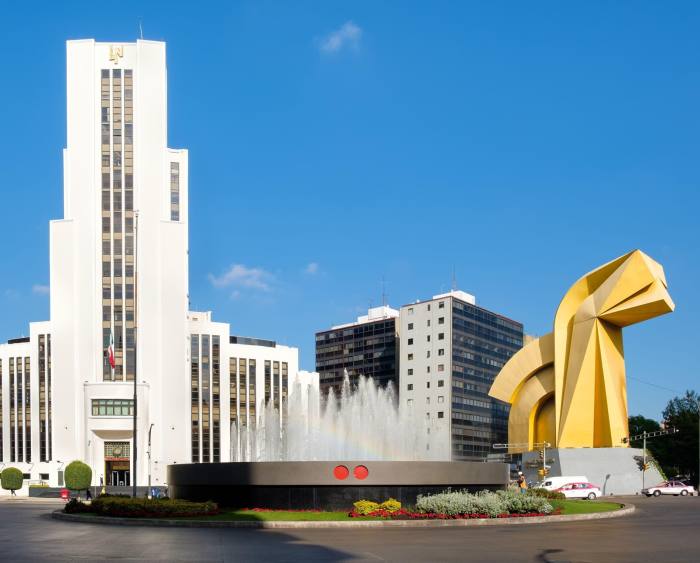
For an easy-paced long run, I love the Polanco/Reforma/Chapultepec corridor. I usually start around the Calzada Mahatma Gandhi circuit, then go along Avenida Presidente Masaryk up to the bridge to Palmas and then back to Mariano Escobedo, but on the return running through Horacio. On Sundays, when Paseo de la Reforma is closed to cars, I do the Gandhi circuit, then Reforma up to the Caballito sculpture and back. For hills, the best spot in town is Bosque de Tlalpan in the south. Those hills gave me the strength I needed while preparing for my first marathon!
— Alan Zamayoa, postgraduate student, Mexico City, Mexico
Back to top
Miami
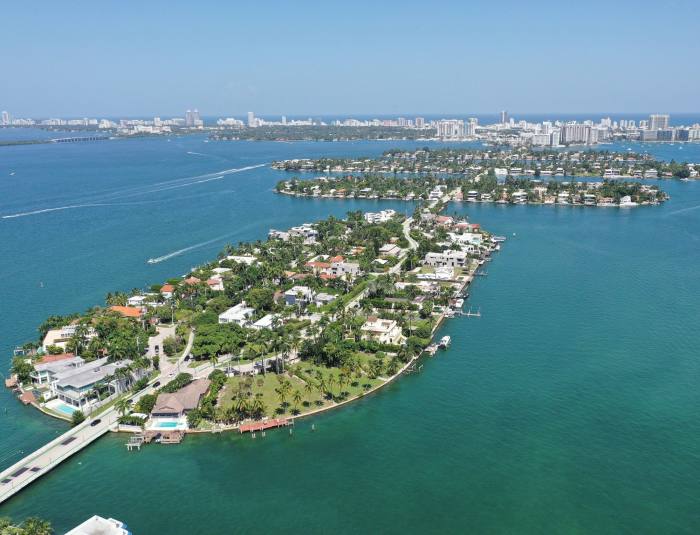
Miami’s Venetian Islands: this a mostly flat, sea-breezy 5k run connecting Miami Beach to Miami (the Edgewater neighbourhood, next to Wynwood). You traverse a series of man-made islands hosting lovely, low-traffic residential neighbourhoods (with direct water access and fancy boat slips) that you can easily dip in and out of to extend your mileage. You will cross a handful of bridges surrounded by bay on both sides, some of which are boat passages (trying to cross them without getting stuck for a boat crossing feels like a fun game as long as you’re not pressed for time, and waiting for only a few minutes with the foot/bike traffic gives a sense of recreational camaraderie).
There is ample sidewalk in both directions as well as bike lanes where you’ll see cyclists and rollerbladers enjoying the same route across the islands. There is also a good amount of greenery, and grassy knolls for lizard spotting. At the Miami Beach end of this run you have The Standard hotel with healthy café options, a day spa and its lovely gardens. At the Miami (Edgewater) end you have a charming bayside park with volleyball, basketball, generous green space and perhaps the best dog park in Miami. Right on the park’s edge is a Pura Vida for healthy smoothies, bowls and sandwiches. The Wynwood neighbourhood for graffiti-mural touring is another mile beyond.
— Bethann Noble, technology marketing, Miami, US
Back to top
Milan

I am new to the city, but was introduced early to Urban Runners by the mayor’s office. They meet weekday mornings at 6.30am, which is a bit early for me, and run near beautiful Parco Sempione, the Arco della Pace and Castello Sforzesco. A morning jog for one short burst, or several random loops around the perimeter if a long run is required, is the perfect kick-start to your day. And a doppio espresso or macchiato normale and cornetto to finish at one of the coffee bars in Piazza Sempione (Duomo or Living) is my ideal refreshment.
— Mike Nithavrianakis, diplomat
Back to top
Montreal
By far, one of the world’s best running routes (coming from someone who’s ran in quite a few places across the world) is the Chemin Olmsted snaking up Montréal’s Mount Royal — our little urban mountain overlooking the city.
It is a 6km path that links up the mountain’s most iconic spots, from the Sir George-Étienne Cartier monument at the bottom, passing the Lac aux Castors (Beaver Lake) and Belvédère Kondiaronk at around the halfway point (overlooking Montréal’s skyline) and the Mount Royal Cross at the top. A round-trip to the summit makes it a good 10km workout with about 140m of elevation.
That route is nice at literally any time of the year, day and night, provided you are dressed properly during the winter. You might need a headlamp at night in the shoulder seasons, but in the dead of winter, the reflections on the snow from the moonlight and city lights are usually sufficient to keep you from kissing the ground or the trees around the path. Bonus during the winter season: half of the track is groomed for cross-country skiing.
Not quite the zoo, but you will still regularly bump into some curious squirrels, hungry raccoons, our usual Canadian birds (red cardinals, blue jays, woodpeckers, etc) and the occasional cavalry horses from the Montreal police force patrolling the area.
Interesting factoid: the Olmsted track is named after the architect/designer of the Mount Royal (Frederick Law Olmsted), who also happened to be behind New York City’s Central Park.
— Vincent Lemay, finance, Montreal, Canada
Back to top
New York City
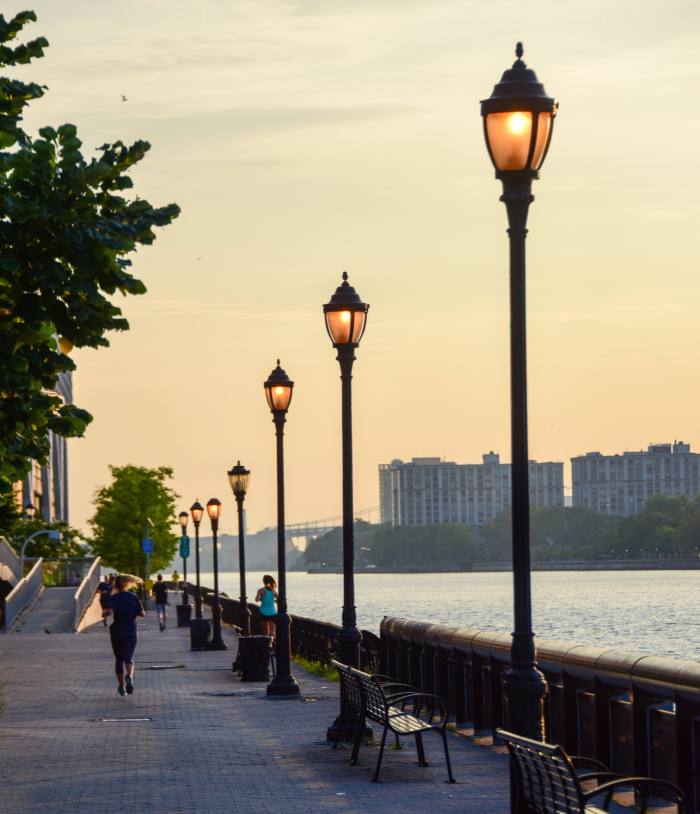
The Hudson River Greenway: In Manhattan, an evening run along the Hudson river is a glorious way to take in the sunset or really any part of the day. The enjoyable greenway stretches from the southern tip of the island up more than 10 miles, and it is entirely flat for almost the entire route. It features an array of parks and recreational amenities, restaurants, cafés, bars, water fountains and other spots for refreshment during and after your run. You can enter and exit the greenway almost every block on its route up to 59th Street, and thereafter every five to 10 blocks, making it possible to construct a route of any distance.
— Roger C Schonfeld, scholarly publishing and academic libraries, New York, US
Two bridges: Despite the obvious draw of trees, trails and rural trip hazards (dodging roots, stones and other obstacles is great for core strength), one of my very favourite runs is an early 10-miler over Manhattan Bridge then back into Manhattan via Brooklyn Bridge.
Starting at Hudson Yards, I head east on 34th, passing Macy’s, and then turn right on Broadway. I love the Flatiron and it’s such a great view of the iconic building as you head towards Union Square.
From there, I continue south down Fourth Avenue and on to Bowery, passing what used to be CBGB but which is now a gallery. What I would give to have seen Blondie or The Damned play there!
Passing through Chinatown and stepping on to Manhattan Bridge is one of the highlights of the run and, as you head towards Dumbo, it’s time to stop to take a photo of the sun hitting the stunning glass cityscape of the Financial District. My collection of pics from the same spot continues to grow.
As you head back over Brooklyn Bridge, you might encounter a couple of newly-weds having a photo taken for the album. But if you’re off at dawn, you’ve a good chance of having the bridge all to yourself.
Once back into Manhattan, I head past City Hall (always reminded of Batman) and into Tribeca. Running north from here on Hudson Street brings you through the supercool West Village into the Meatpacking District.
From Little W 12th Street, I have the choice of joining the High Line (if it’s still early enough to avoid the sightseers) or taking the Hudson River Greenway back north. There’s an epic view of Edge from the former and the Greenway offers an alternative view of the Empire State Building.
Either route will take you back to the start point at Hudson Yards (take W 33rd Street if you chose the Greenway to return to base).
— Kieron James, CEO/Founder, London, England
Back to top
Nice
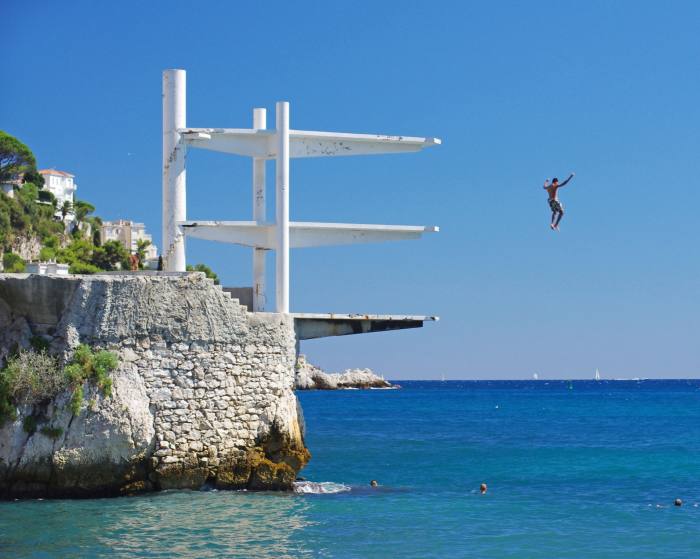
I moved to Nice in 2016 after having lived in Paris for more than 15 years. I have grown to love this city more with each year I spend here — it is a true jogger and cyclist paradise. I live in a hilltop résidence which sits behind the famous Promenade des Anglais, about halfway between the airport and the old town in a district called Magnan. A brisk five-minute downhill start to my jog will take me on to the “Prom”, as the locals call it, and, depending on energy levels and tourist numbers, decide whether to go right or left.
A right turn will take me away from the tourist masses towards the airport along a dedicated pedestrian track completely uninterrupted by cars. Upon reaching the airport (4km), the route runs alongside the private-jet parking area (this is Nice, after all) towards the terminals and over the Napoléon III bridge, past the world-renowned Cap 3000 shopping mecca where a convenient loop presents me with the option of turning back to Magnan, at which point I will have completed a 13km trip.
Alternatively, I can continue westwards into the next town, Saint Laurent du Var, right through its newly renovated marina and on to the seaside path that runs through Cagnes-sur-Mer. If I’m feeling particularly energetic, I’ll continue past the Hippodrome de la Côte d’Azur and towards the symbolic pyramid structures of the Marina Baie des Anges apartments in Villeneuve Loubet, which are often the first buildings arriving tourists can see on the approach into landing at Nice airport. This is the farthest I’ve run in this direction, and when I turn back at this point towards home, I will have completed the full half-marathon on a beautiful, flat and picturesque route peppered with water points at 2km intervals and, in Nice itself, a choice of still or sparkling water at its municipal water fountains.
Had I turned left at the starting point, I could have taken the more challenging option of navigating the large numbers of tourists, e-scooters and skateboarders towards the headland of the Prom, home to the infamous “I Love Nice” photo point and then around past the port, the hub of Nice nightlife until I reach the ferry terminal with its multiple daily sailings to Corsica. At this point, Nice gradually becomes less touristy and the neighbourhood becomes distinctly more upmarket. Sean Connery’s former house looms large over the locals’ preferred rocky bathing spot La Réserve, and here the route becomes quite hilly as I climb towards the stunning heights of Mont Boron. The route is dominated by joggers and cyclists and water points are plentiful. The spectacular views are a constant distraction from the energy expended to reach the higher jogging path, which continues out past the Cape of Nice headland and down a gentle hill into the glorious village of Villefranche.
Film crews are quite common along this step, as are double-parked rental cars of tourists taking photos of the Bay of Villefranche and the monument to Princess Grace. Jogging along the road towards Villefranche, along winding steps towards the heights of Mont Boron, with its extensive forested park lands, offers incredible views of the entire Bay of Nice. A gentle U-turn in Villefranche, next to scenic playing fields perched above the Mediterranean with the lighthouse of Cap Ferrat across the water, leads me back along the same uninterrupted stretch towards home with a decidedly more hilly half marathon under my belt.
I have lost count of the number of times I have jogged these routes or various permutations of them and have memories of the most wonderful sunsets, spontaneous exchanges with fellow joggers as they take a breather at the numerous water points and sights of tourists from all corners of the world as they marvel at the beauty of this storied and truly captivating corner of France. Upon returning home, I will more often than not bump into one of my neighbours who will inevitably have also completed some outdoor pursuit before wandering down into the old town to enjoy the many nocturnal and less strenuous activities this amazing city has to offer.
— Gary Fallon, CEO, Nice, France
Back to top
Oxford
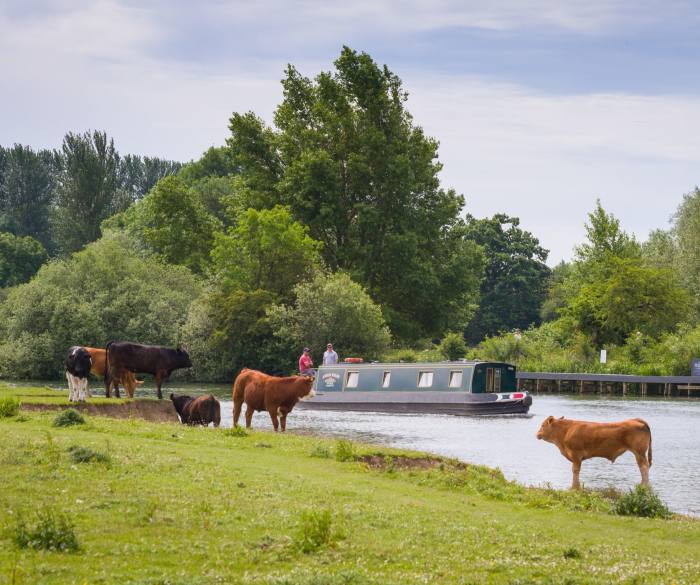
The best place to run in Oxford is Port Meadow. Head to The Victoria pub on Walton Street before heading along Walton Well Road and over the bridge into Port Meadow. The best circular run is head straight to the river and cross two bridges before turning right along the Thames Path all the way to Godstow. At the swing gate back on to the road, turn right over the river and in to Wolvercote. After about 500m you will find a large car park and entrance back into Port Meadow: rejoin the Thames Path to meander back to the start of the run.
— James Hammersley, runner, Oxford, UK
Back to top
Paris
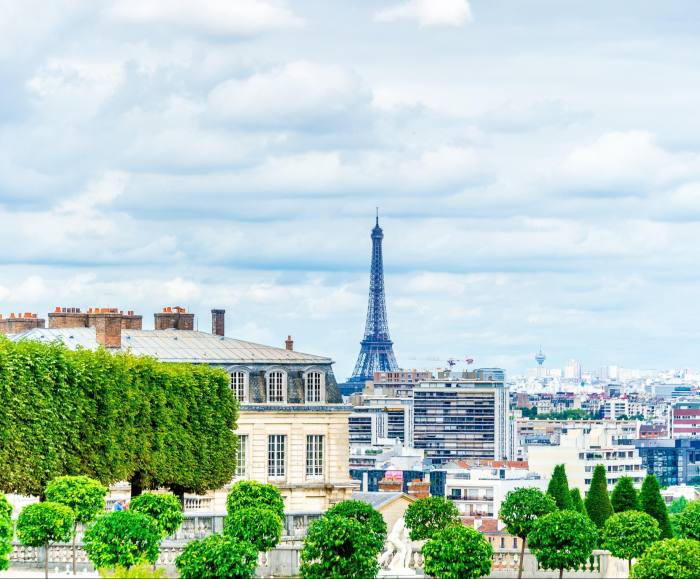
Parc de Saint-Cloud: The weekend being the only time in the week when I get to go on long runs in Paris, I love to go to the Parc de Saint-Cloud, a vast and diverse green space between Paris and Versailles. Once Napoléon III’s palace and domain, it is now mostly covered by grass and wide alleys on its side facing Paris, and by woods and underwood otherwise, and for this reason makes for a perfect running playground that feels light years away from the stress of Parisian day-to-day life.
It is located on a hill overlooking Paris’s skyline and the view is extremely rewarding when running back from a morning run. The park’s depth and variety of paths, from neat large paths to narrow trails between ferns, provides endless combinations for 10k, 15k or longer runs, and it is connected to various other forests that are even wilder and more remote (and especially sought after by trail runners living in Paris).
I would advise cold-morning runs in the fall to enjoy the low sunlight and the leaves’ bright colours, as well as the mists trapped between the trees. A highlight is the Lafayette Escadrille Memorial Cemetery, an arch-shaped American monument that seems to come straight from the National Mall in Washington DC, and is located close to a charming and often deserted pond. I usually run around this monument around the end of my session, so that its peace and calm feels like a reward for all my efforts, and I briefly pause for a snack, before heading back to urban life and all week aching to run back there again.
— Jules Le Roux, legal counsel, Paris, France
Parc des Buttes-Chaumont is my favourite place to run on the weekend in Paris. Parisien/nes enjoy magnificent views of their city on the hilly 2k loop, possibly pretending like me that each incline is helping realise their summer trail-running dreams in the Alps. The park is green, a colour not associated with my working week in central Paris, so that alone draws me back each weekend. Of course there are multiple café options post-run: a drink in the park at Le Pavillon Du Lac, brunch at Sunny (the perfect name for its terrace overlooking the park) or Ten Belles to refuel those depleted carbs!
— Prue Mackenzie, technology, Paris, France
Back to top
Rio de Janeiro
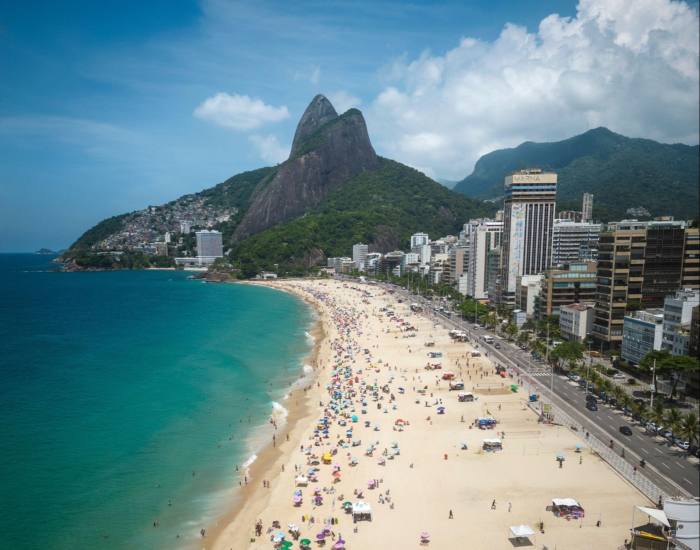
There are many places to run in Rio de Janeiro, such as Lagoa (Fernando Freitas lake) and Vista Chinesa (the Chinese-style observation deck). But the running track I have been enjoyed the most over the past few years is the Leblon-Arpoador beach route. If you do it early in the morning, you will feel the sun rising in the horizon and the heat that makes Rio unique; in the evening, you will experience the most beautiful sunset in Brazil. If you want to improve resistance, you can run in the sand, but most people do this track on the concrete as it is well preserved, even though the Ipanema portion is slightly inclined (amateurs like me won’t be bothered). Usually this route takes about 35-45 minutes, but it is always an investment that pays back. Afterwards, you can get an água de coco (coconut water) or a caipirinha nearby as it is not hard to find somewhere that sells them — but it is much harder to find a better place to start your day in Rio.
— Pompeu Hoffmann, senior economist, Rio de Janeiro, Brazil
Back to top
Rome
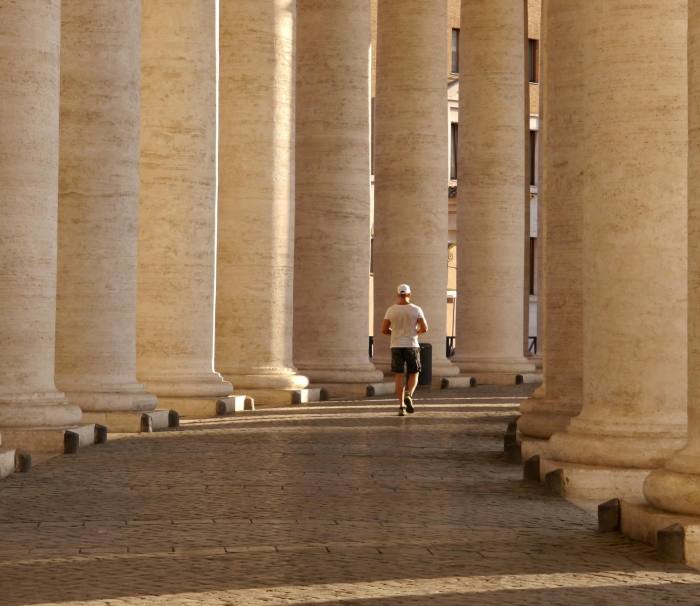
When you are in Rome, you have a singular opportunity to circumnavigate a sovereign nation. To do so, head across the river and run a lap around the Vatican. You’ll see the more familiar parts of the grand entrance to St Peter’s and also appreciate the medieval city walls in the less travelled and quite a bit hillier parts of the route.
— Roger C Schonfeld, scholarly publishing and academic libraries, New York, US
Back to top
San Francisco
Twin Peaks: Despite having lived in San Francisco for over 20 years, I never get bored of the views from the top of Twin Peaks, the second-highest point in San Francisco, at 922 feet. In a normal week, I run from my home in Noe Valley to Twin Peaks, three to four times a week, an almost five-mile run [there and back] with a total gain of about 650 feet.
It often surprises visitors, even from other parts of California, that San Francisco often spends the summer months shrouded in fog, so there’s not much change to the average morning temperature year round.
There are very few flat areas in San Francisco, so you have to get comfortable with hills living here. I’m an annoying morning person, and love seeing sunrise over the city. My run starts with the first quarter mile going up two of the steepest blocks in the city, with my heart pounding, but from there the next couple of miles are a more gentle climb to the summit.
Unusually, for a city run, there are few intersections on Diamond Heights and Portola Drive, before turning on to Twin Peaks Boulevard and the switchback climb to the summit. There’s a trail to one side of the road, but the traffic is light in the morning, and you’ll often have groups of cyclists on their rides to the summit. A quarter of a mile up, you get your first view of the Bay. I’ll often stop here to take a picture of the sunrise and count the number of container ships moored in the Bay. During Covid, it peaked at 22, but today it’s closer to 15. Occasionally I’ll see a coyote, which are quite common in San Francisco’s parks — another surprise for visitors!
Having grown up in the UK, I’m often reminded of Scotland as I run past the gorse embankments. At the two-mile mark you get the first view of the Pacific, looking north to Point Reyes. On a clear day, you can see the Farallon Islands, some 30 miles out from San Francisco, and then the road flattens out for the last half-mile to the summit. It’s here that you get the most spectacular view of downtown San Francisco, looking out to the East Bay and Mount Diablo. You can see Alcatraz quite clearly and the Golden Gate Bridge, which, after 20 years, still leaves me feeling grateful to live here. There’s not a day I don’t stop here, even in the rain or fog, take a picture and appreciate that I get to call this place home.
The the run home is all downhill, and the prize for slogging my way up.
— Gerald Brady, banker, San Francisco, USA
Golden Gate run: Every year at Christmas time our family visits San Francisco and stays at the Inn at the Presidio. And every year I do my annual 13-mile Golden Gate run. Because it’s December, the weather is usually a perfect combination of cool and sunny. This is one of my favourite routes in the world.
Start at the Presidio of San Francisco or at the beautiful and scenic Crissy Field. Run towards the Golden Gate Bridge. Cross it, then at the north end go under the bridge and find the trail that leads to Conzelman Road. Take it all the way to the top: a spectacular viewpoint over San Francisco, the headlands and the Pacific Ocean. Continue on Conzelman down the other side, heading out towards the Pacific Ocean. Run to the old Nike Missile Site, right on Field Road, then right on Bunker Road.
Important option: as you go down Bunker Road, find the trail that goes off to the right and parallels it. It’s fantastic and will take you all the way to the Coastal Trail parking lot. Once at the parking lot, cross McCullough Road and take the trail that continues to Slackers Hill. This is a gruelling but short uphill. Check out Slackers’ viewpoint, or just continue on the trail as it wraps around the mountain and returns you to Conzelman Road. From there, head back across the GG Bridge and home stretch to the Presidio. It’s a spectacular, classic San Francisco run!
— Chris Vargas, investor, Palo Alto, USA
Back to top
Shanghai
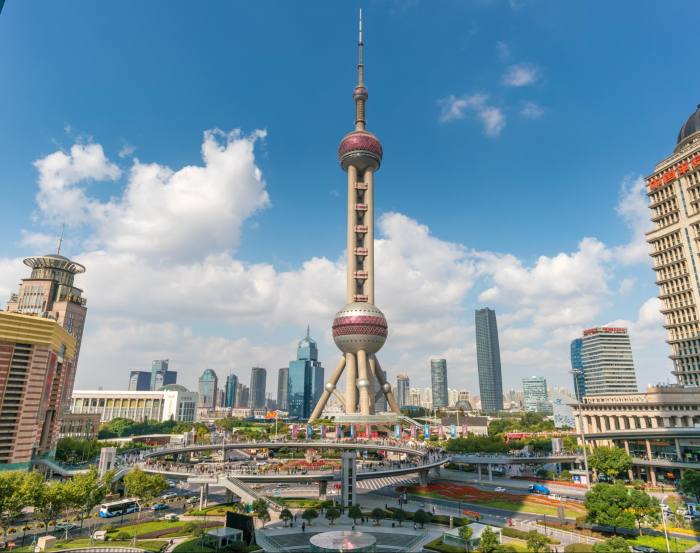
My favourite route is along the eastern Bund of the Huangpu river, which runs through the city (splitting Shanghai into Puxi and Pudong areas). One end of the route is the Oriental Pearl Tower, arguably the most famous TV tower in China. You could enjoy the modern skyscrapers (the Shanghai Center being more than 600m tall) near you and the famous historical buildings across the river. The other end is the Shanghai Expo area that includes the UFO-shaped Mercedes-Benz Arena and other signature stadiums.
There are also several small parks and wetlands along the route. You’ll also see cargo ships and yachts on the river. Of course, if you want to enjoy a cup of coffee or a beer after the run, they are very accessible along the route. All in all, it is a mixture of modern-day and historic sites (the eastern Bund and the western Bund), elegance and magnificence (the shops, parks, living areas and the Huang river, ships, skyscrapers), and is unique and enjoyable. What’s more special is that the day and night views are very different — the light shows from the buildings, bridges and ships can give runners a completely new experience.
— Zichao Wu, management consultant, Shanghai, China
Back to top
Singapore
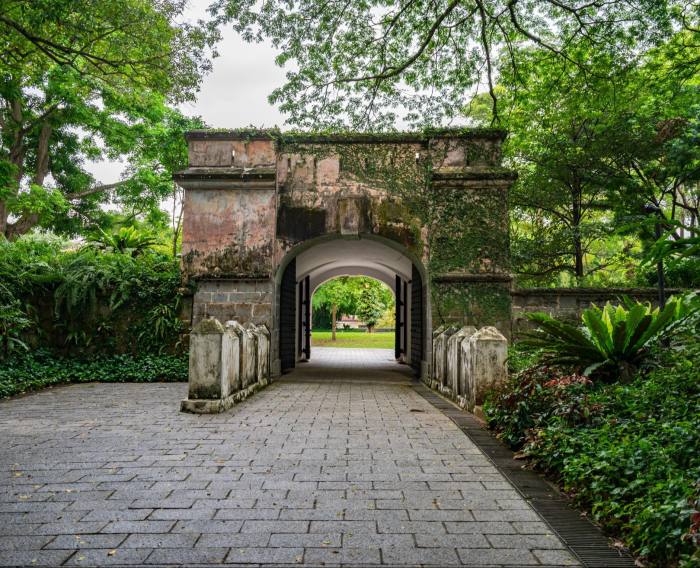
Fort Canning Park: I lived in Singapore for more than seven years in the early 2000s. When I travel back now, my favourite run is in Fort Canning Park, a historically significant spot that sits on a hill overlooking the city centre and bay area. I go before dawn to beat the heat, and run up the hill to Fort Canning Park and then climb the many steps to get to the paths that encircle the reservoir at the top. Don’t miss running through the Fort Gate. The park is lush and has multiple gardens — and it’s quite wonderful to enjoy them in the early morning with all of the fragrances and sounds. I’ll do two loops or maybe a third depending on time — you are surrounded by gardens and greenery on all of the paths. They are well lit and well drained, even it has rained overnight. You’ll hear both the quiet and the sounds of the surrounding gardens waking up, and look down on the city as it comes to life. Great way to start the day and get energy in a beautiful spot.
— Nathan Zietlow, attorney, St Paul, US
Marina Bay: I used to run through Marina Bay after work whilst living in Singapore. I loved the contrast of starting from my office in the centre of the city, with the buzz of people leaving to go home, heading past the spectacular Marina Bay Sands hotel just as it was beginning to light up and through the peaceful Gardens by the Bay. If you are lucky enough, you may even spot an otter or two. Depending on how energetic, I was feeling I would continue along to the East Coast Park (turning the run from a 10k into a 15k) to watch the sun go down over the Singapore Strait, before turning around and more often than not stopping for some chicken satay and plenty of water (and maybe a beer) from Lau Pa Sat on the way back into the city. A flat, fast route, but be warned that running in such humidity will mean your pace will be way off what you are used to.
— Josh Bell, wealth management, Surbiton, UK
Back to top
Stockholm
Stockholm is a beautiful city, but there are not many areas to run near the centre. We usually stay in Östermalm, close to the harbour. We run east along the waterfront path by Strandvägen, with the boats on our right and beautiful (and expensive) turn-of-the-century apartments on our left. We keep straight and continue on the north-shore running path of the Djurgårdsbrunn waterway. We pass embassies, churches, a small hotel, and end up running along the Royal Canal along Prins Bertils Way. You can cross Lilla Sjötullsbron bridge and run back along the south shore (Prins Carls Way), but we extend the run to a place that most runners never find. If you follow the shore, always staying on the main path, for another 10 minutes, you come to the Djurgårdens Kyrkogård/Kaknäs Djurkyrkogård — a pet cemetery. It’s filled with both famous animals and local pets. Mainly cats and dogs, but with beautiful engravings, candles, flowers and pictures of much-missed companions. We’ve never seen anything like it, and we take some time and think about all the loving animals we’ve had over the years. A few tears may be shed. Then we run back to Lilla bridge, and along the southern path, admiring the royal residences along the way, and trying not to get ridden over by a princess or two on their horses (true story).
— Duncan Stewart, research director, Toronto, Canada
Back to top
Sydney
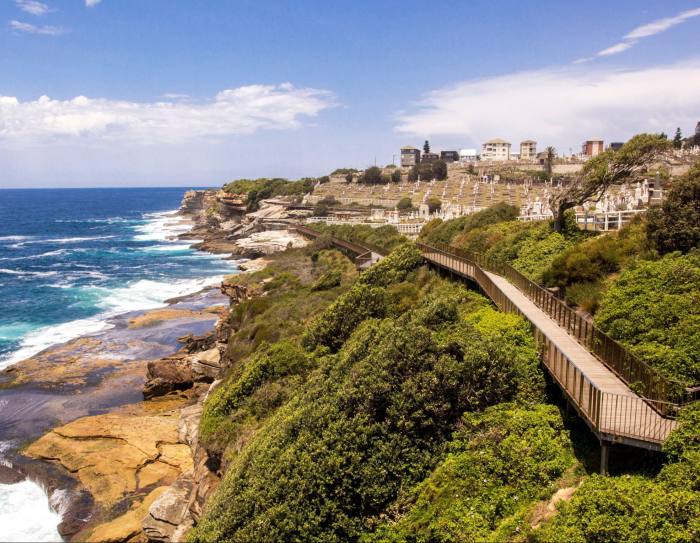
Bondi to Coogee Beach: Run south from Bondi Beach, up past Bondi Icebergs, around the hill to Tamarama beach, then around the next hill to Bronte beach, past Waverley Cemetery, then Clovelly Beach and Gordon’s Bay to end up at Coogee Beach.
This is best done at sunrise. Grab a smoothie at Coogee Beach as you watch the sun come up. The entire run is about 6-7km with a decent amount of climbing. Think of it more like a trail run rather than a run you would do intervals on.
— Sameer Madan, founder and CTO, New York, US
Darling Harbour to the Opera House: My favourite run is in Sydney, done in the early morning as the sun comes up. Starting in Darling Harbour, run along the harbour and pass the new Barangaroo buildings, then around Walsh Bay where the fishermen are often out in force. Emerging from the wharves, you head under Harbour Bridge and then before you stretches one of the most spectacular skylines in the world, with the Opera House standing in splendid serenity as the sun rises behind its curves. As you head towards Circular Quay, there is often a large cruise ship coming in to dock, competing with the tiny ferries buzzing around. Run around to the Opera House, where you face a number of options. You can head into the Royal Botanic Gardens and out towards Potts Point, or return via Circular Quay before climbing up through the Rocks to the Harbour Bridge. The bridge represents a 3km extension, trading some spectacular views for the accompanying traffic flows.
You can run as far or as little as you like. Darling Harbour to the Opera House is 5km each way. The Gardens can add another 3-5km, as does the Harbour Bridge.
What makes this route so spectacular? It offers breathtaking views that change at every step. You can tailor your run to as long or as short as you want. And different times of day offer different perspectives in an ever-changing landscape.
— Peter Diamond, banker, Brisbane, Australia
Back to top
Tokyo
Waking up early to greet the sun as it slowly climbs above the magnificence of Tokyo’s Imperial Palace walls, reflecting off the wide moat around the grounds, is truly awe-inspiring. The famous loop around the palace is a well-paved and unbroken 5km, and provides incredible scenery throughout the course that reflects the unique marriage of history and modernity that runs throughout the city. Palace buildings built in the traditional style are juxtaposed with the modern buildings of Marunouchi and other surrounding areas, and runners who are lucky enough to time their travels perfectly can see the cherry blossoms in full bloom, which is one of the great highlights that the country has to offer.
Japan has a proud history with — and uncanny talent for — distance running, and ambitious runners can often find talented pacers to keep up with on the undulating course, and the loop supports all training sessions well, from long runs to shorter tempo runs. However, early mornings find the route lightly occupied, giving runners the ability to cruise at their own preferred speed without feeling overwhelmed. There are restrooms and water stations along the way as well as an added perk of running shops, like the nearby Asics Run Marunouchi, which happily rent out shoes and kit for under-equipped travellers.
— Ryan Myerberg, investment management, London, UK
Back to top
Vancouver

The Grouse Grind: a 20-minute drive from the city centre through beautiful Stanley Park and across the Lions Gate bridge, this 2.5km trail up Grouse Mountain is challenging and absolutely magical. Sometimes called “Nature’s StairMaster”, it takes an hour or so to complete and leads through pristine forest up to a spectacular panorama over Vancouver and the Pacific Ocean. Take the gondola down for more epic views. It is a favourite with locals and has rightly become an institution. Whenever I visit, it is on my must-do list and never disappoints.
— Bruno Vander Cruyssen, retired banker, Milan, Italy
Back to top
Zurich
In Zurich, start at Saalsporthalle public transport stop, and run into the forest/park under the Uetliberg mountain. For a flat run, just follow the road through the dog park and along the river and run for as long as you wish — take one of the bridges to cross over and run back. For those who want hills, there are various cut-offs to run up the mountain. It’s a safe route with no cars, no stop lights, just walkers, runners and friendly dogs. If you’re lucky, you might even get to see the Zurich FC team train in the football fields next to the running path.
This is great to run in the spring and summer, but also amazing on a winter day when there’s a big wall of fog in front of you. Avoid on very wet days, as the route is partially trails and may be quite slippery/muddy.
— Pranav Kabra, private equity, Zurich, Switzerland
Back to top
Tell us about your favourite city runs in the comments
This story originally appeared on: Financial Times - Author:FT readers respond

























